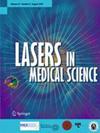求助PDF
{"title":"Thulium fiber laser versus pulsed Thulium:YAG for laser lithotripsy during flexible ureteroscopy.","authors":"Frédéric Panthier, Catalina Solano, Marie Chicaud, Stessy Kutchukian, Luigi Candela, Steeve Doizi, Mariela Corrales, Olivier Traxer","doi":"10.1007/s10103-024-04267-w","DOIUrl":null,"url":null,"abstract":"<p><p>To compare the pulsed-Thulium: YAG(p-Tm: YAG) and Thulium Fiber(TFL) lasers in terms of efficiency and safety profiles during flexible ureteroscopy(fURS) and endocorporeal laser lithotripsy(ELL). A prospective single-center open-label comparative study included consecutive patients with ureteral and renal stones who underwent fURS using Thulio(p-Tm: YAG, Dornier©,Germany) or TFL Drive(TFL, Coloplast©,Danemark), with 270 μm and 150/200μm laser fibers(LF), respectively. fURS were performed by a single operator in each group. Demographics, stone size, stone density, laser-on time(LOT) and laser settings were recorded. Ablation speed(mm<sup>3</sup>/s), energy consumption(J/mm<sup>3</sup>) values for each procedure were also assessed. Stone-free rate(SFR, <3 mm fragments) and zero fragment rate(ZFR) on non-contrast computed tomography within 3 months postoperatively were also recorded. 36 and 39 patients were included in p-Tm: YAG and TFL group, respectively. Groups presented similar demographics but for high blood pressure(53vs23%,p = 0,005), anatomical abnormalities(8vs33%,p = 0,03), lower pole(8vs26%,p = 0,04) and pelvic stones(25vs13%,p = 0,04) for p-Tm: YAG and TFL, respectively. The median stone maximum diameter was higher in the p-Tm: YAG group(17.3vs13.8 mm, p = 0,001) but stone volume was similar among groups(1514vs1347mm<sup>3</sup>,p = 0,6). Laser settings were similar among groups(0,6-15 Hz,10-12 W). Shorter LOT(< 0,001) and lower UAS insertion(0,01) rates were reported for TFL compared to p-Tm: YAG. The median J/mm<sup>3</sup> was similar(14vs17,p = 0,2) but p-Tm: YAG presented higher ablation speed(0,91vs0,73mm<sup>3</sup>/s, p = 0,04). SFR were similar among groups(75vs77%,p = 0,8) but ZFR was higher in TFL group(39vs64%,p = 0,008). No difference in complications was reported. Both p-Tm: YAG and TFL are safe and effective for ELL during fURS. SFR were similar between TFL and p-Tm: YAG but the latter presented lower ZFR, traducing its lower ability to dust. Using 200 μm laser fibers with p-Tm: YAG could nuance these findings.</p>","PeriodicalId":17978,"journal":{"name":"Lasers in Medical Science","volume":"39 1","pages":"294"},"PeriodicalIF":2.1000,"publicationDate":"2024-12-16","publicationTypes":"Journal Article","fieldsOfStudy":null,"isOpenAccess":false,"openAccessPdf":"","citationCount":"0","resultStr":null,"platform":"Semanticscholar","paperid":null,"PeriodicalName":"Lasers in Medical Science","FirstCategoryId":"5","ListUrlMain":"https://doi.org/10.1007/s10103-024-04267-w","RegionNum":4,"RegionCategory":"医学","ArticlePicture":[],"TitleCN":null,"AbstractTextCN":null,"PMCID":null,"EPubDate":"","PubModel":"","JCR":"Q3","JCRName":"ENGINEERING, BIOMEDICAL","Score":null,"Total":0}
引用次数: 0
引用
批量引用
Abstract
To compare the pulsed-Thulium: YAG(p-Tm: YAG) and Thulium Fiber(TFL) lasers in terms of efficiency and safety profiles during flexible ureteroscopy(fURS) and endocorporeal laser lithotripsy(ELL). A prospective single-center open-label comparative study included consecutive patients with ureteral and renal stones who underwent fURS using Thulio(p-Tm: YAG, Dornier©,Germany) or TFL Drive(TFL, Coloplast©,Danemark), with 270 μm and 150/200μm laser fibers(LF), respectively. fURS were performed by a single operator in each group. Demographics, stone size, stone density, laser-on time(LOT) and laser settings were recorded. Ablation speed(mm3 /s), energy consumption(J/mm3 ) values for each procedure were also assessed. Stone-free rate(SFR, <3 mm fragments) and zero fragment rate(ZFR) on non-contrast computed tomography within 3 months postoperatively were also recorded. 36 and 39 patients were included in p-Tm: YAG and TFL group, respectively. Groups presented similar demographics but for high blood pressure(53vs23%,p = 0,005), anatomical abnormalities(8vs33%,p = 0,03), lower pole(8vs26%,p = 0,04) and pelvic stones(25vs13%,p = 0,04) for p-Tm: YAG and TFL, respectively. The median stone maximum diameter was higher in the p-Tm: YAG group(17.3vs13.8 mm, p = 0,001) but stone volume was similar among groups(1514vs1347mm3 ,p = 0,6). Laser settings were similar among groups(0,6-15 Hz,10-12 W). Shorter LOT(< 0,001) and lower UAS insertion(0,01) rates were reported for TFL compared to p-Tm: YAG. The median J/mm3 was similar(14vs17,p = 0,2) but p-Tm: YAG presented higher ablation speed(0,91vs0,73mm3 /s, p = 0,04). SFR were similar among groups(75vs77%,p = 0,8) but ZFR was higher in TFL group(39vs64%,p = 0,008). No difference in complications was reported. Both p-Tm: YAG and TFL are safe and effective for ELL during fURS. SFR were similar between TFL and p-Tm: YAG but the latter presented lower ZFR, traducing its lower ability to dust. Using 200 μm laser fibers with p-Tm: YAG could nuance these findings.
输尿管软镜激光碎石中铥光纤激光与脉冲铥YAG的对比。
比较脉冲铥:YAG(p-Tm: YAG)和铥纤维(TFL)激光器在柔性输尿管镜检查(fURS)和体内激光碎石术(ELL)中的效率和安全性。一项前瞻性单中心开放标签比较研究包括连续输尿管结石和肾结石患者,他们分别使用Thulio(p-Tm: YAG, Dornier©,德国)或TFL Drive(TFL, Coloplast©,丹麦),分别使用270 μm和150/200μm激光光纤(LF)进行fURS。每组由一名操作者进行fURS。记录了人口统计学、石材尺寸、石材密度、激光开机时间(LOT)和激光设置。还评估了每个过程的消融速度(mm3/s)、能耗(J/mm3)值。无石率(SFR, 3,p = 0,6)。各组激光设置相似(0,6-15 Hz,10-12 W),较短的LOT(3)相似(14vs17,p = 0,2),但p- tm: YAG具有更高的烧蚀速度(0,91vs0,73mm3/s, p = 0,04)。两组间SFR相似(75.vs77%,p = 0,8),但TFL组ZFR较高(39vs64%,p = 0,008)。并发症发生率无差异。p-Tm: YAG和TFL对fURS期间的ELL均安全有效。TFL与p-Tm: YAG的SFR相似,但p-Tm: YAG的ZFR较低,表明其抑尘能力较弱。使用含有p-Tm: YAG的200 μm激光光纤可以细微地改变这些发现。
本文章由计算机程序翻译,如有差异,请以英文原文为准。


